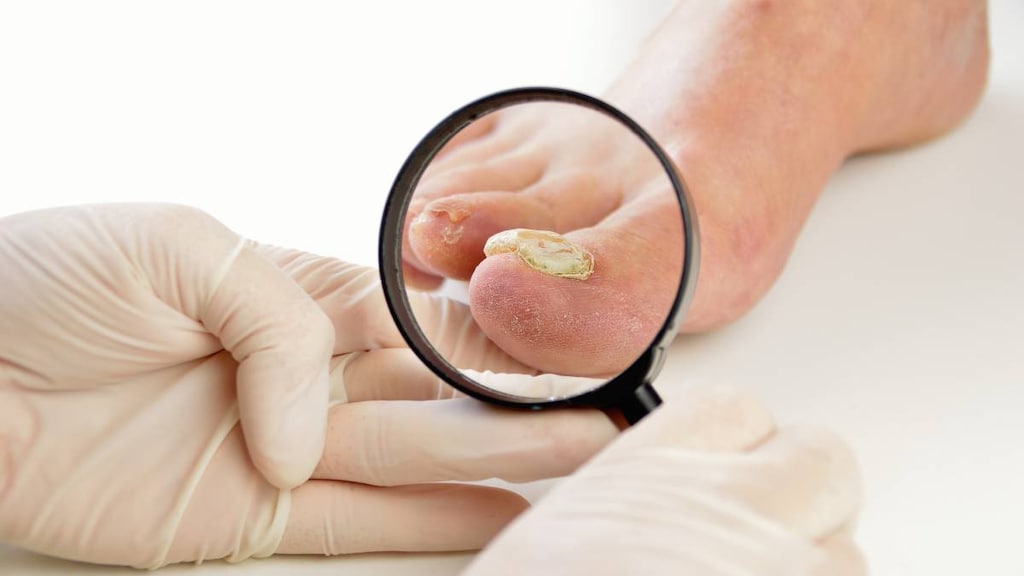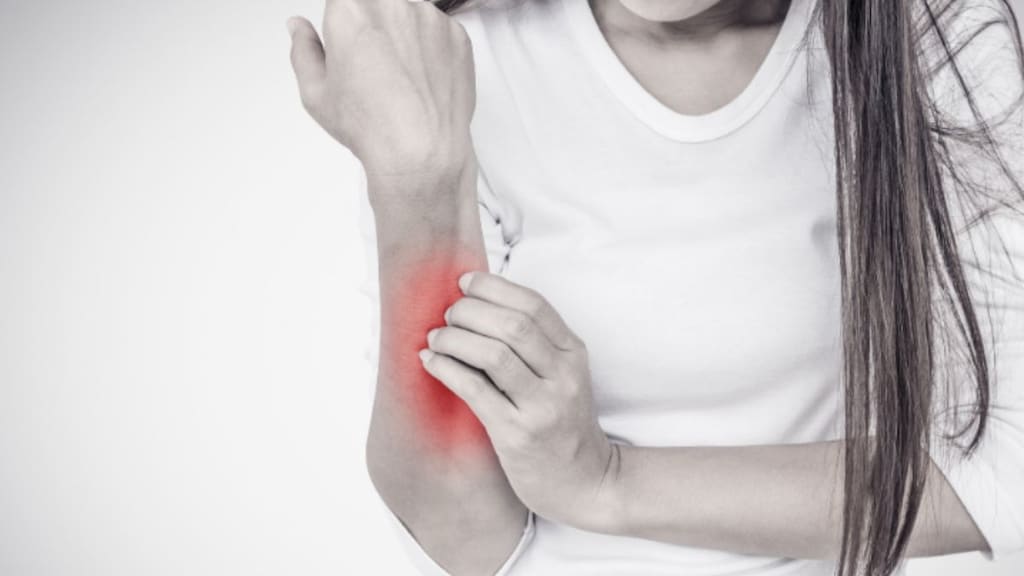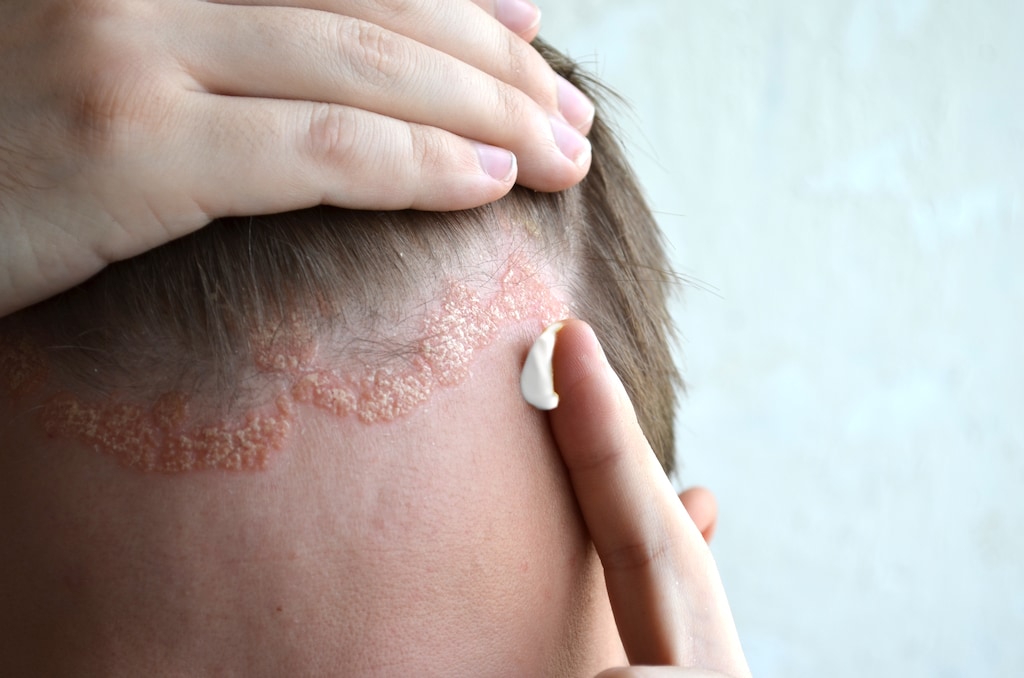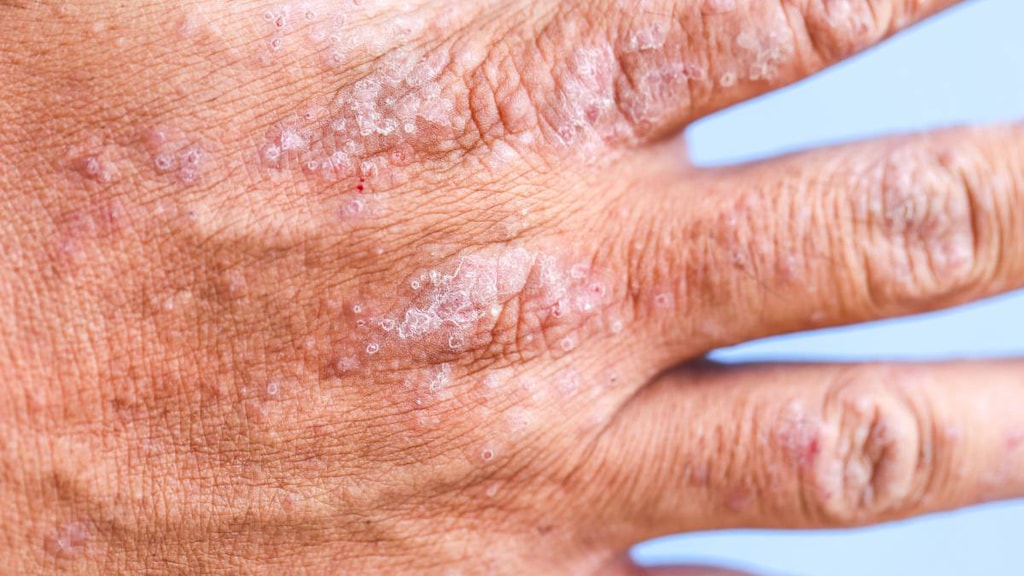Dosage Forms
Excipient information presented when available (limited, particularly for generics); consult specific product labeling.
Cream, External:
Vanos: 0.1% (30 g, 60 g, 120 g)
Generic: 0.05% (15 g, 30 g, 60 g, 120 g); 0.1% (30 g, 60 g, 120 g)
Gel, External:
Generic: 0.05% (15 g, 30 g, 60 g)
Ointment, External:
Generic: 0.05% (15 g, 30 g, 60 g)
Solution, External:
Generic: 0.05% (20 mL, 60 mL)
Pharmacology
Mechanism of Action
Topical corticosteroids have anti-inflammatory, antipruritic, and vasoconstrictive properties. May depress the formation, release, and activity of endogenous chemical mediators of inflammation (kinins, histamine, liposomal enzymes, prostaglandins) through the induction of phospholipase A2 inhibitory proteins (lipocortins) and sequential inhibition of the release of arachidonic acid. Fluocinonide is fluorinated corticosteroid considered to be of high potency.
Pharmacokinetics/Pharmacodynamics
Absorption
Dependent on formulation, amount applied and nature of skin at application site; may be increased with inflammation or occlusion
Metabolism
Hepatic
Excretion
Primarily urine; bile
Use: Labeled Indications
Inflammatory and pruritic dermatologic conditions: Relief of the inflammatory and pruritic manifestations of corticosteroid-responsive dermatoses.
Contraindications
Hypersensitivity to fluocinonide or any component of the formulation
Dosage and Administration
Dosing: Adult
Atopic dermatitis: Topical:
Cream, gel, ointment, solution (0.05%): Apply thin layer to affected area 2 to 4 times daily.
Cream (0.1%): Apply thin layer to affected areas once daily. Not recommended for use >2 consecutive weeks or >60 g/week total exposure. Therapy should be discontinued when control is achieved; if no improvement is seen within 2 weeks, reassessment of diagnosis may be necessary.
Psoriasis: Topical:
Cream, gel, ointment, solution (0.05%): Apply thin layer to affected area 2 to 4 times daily.
Cream (0.1%): Apply a thin layer once or twice daily to affected areas. Not recommended for use >2 consecutive weeks or >60 g/week total exposure. Therapy should be discontinued when control is achieved; if no improvement is seen within 2 weeks, reassess diagnosis.
Other inflammatory and pruritic dermatologic conditions besides atopic dermatitis or psoriasis: Topical:
Cream, gel, ointment, solution (0.05%): Apply thin layer to affected area 2 to 4 times daily.
Cream (0.1%): Apply thin layer to affected area once or twice daily. Not recommended for use >2 consecutive weeks or >60 g/week total exposure. Therapy should be discontinued when control is achieved; if no improvement is seen within 2 weeks, reassess diagnosis.
Dosing: Geriatric
Refer to adult dosing.
Dosing: Pediatric
Atopic dermatitis:
Cream, gel, ointment, topical solution (0.05%): Children and Adolescents: Topical: Apply thin layer to affected area 2 to 4 times daily depending on the severity of the condition. Note: In children <12 years, NICE guidelines recommend applying only once or twice daily (NICE 2007).
Cream (0.1%): Children ≥12 years and Adolescents: Topical: Apply a thin layer once daily to affected areas. Not recommended for use >2 consecutive weeks or >60 g/week total exposure. Therapy should be discontinued when control is achieved; if no improvement is seen within 2 weeks, reassessment of diagnosis may be necessary.
Corticosteroid-responsive dermatoses (including psoriasis):
Cream, gel, ointment, topical solution (0.05%): Children and Adolescents: Topical: Apply thin layer to affected area 2 to 4 times daily depending on the severity of the condition; may use occlusive dressings to manage psoriasis or recalcitrant conditions
Cream (0.1%): Children ≥12 years and Adolescents: Topical: Apply a thin layer once or twice daily to affected areas. Not recommended for use >2 consecutive weeks or >60 g/week total exposure. Therapy should be discontinued when control is achieved; if no improvement is seen within 2 weeks, reassess diagnosis.
Administration
For topical use only. Apply sparingly in a thin film. Rub in lightly. Avoid contact with eyes. Wash hands after application (unless hands are part of the treatment area).
Lower-strength formulations (0.05%) may be used cautiously on face or opposing skin surfaces that may rub or touch (eg, skin folds of the groin, axilla, and breasts); higher-strength (0.1%) should not be used on the face, groin, or axillae. Occlusive dressings significantly increase percutaneous absorption and may be used with fluocinonide 0.05% for the management of psoriasis or recalcitrant conditions only as determined by healthcare provider (monitor; adverse events may be increased).
Storage
Store at room temperature; avoid excessive heat.
Drug Interactions
Aldesleukin: Corticosteroids may diminish the antineoplastic effect of Aldesleukin. Avoid combination
Corticorelin: Corticosteroids may diminish the therapeutic effect of Corticorelin. Specifically, the plasma ACTH response to corticorelin may be blunted by recent or current corticosteroid therapy. Monitor therapy
Deferasirox: Corticosteroids may enhance the adverse/toxic effect of Deferasirox. Specifically, the risk for GI ulceration/irritation or GI bleeding may be increased. Monitor therapy
Hyaluronidase: Corticosteroids may diminish the therapeutic effect of Hyaluronidase. Management: Patients receiving corticosteroids (particularly at larger doses) may not experience the desired clinical response to standard doses of hyaluronidase. Larger doses of hyaluronidase may be required. Consider therapy modification
Ritodrine: Corticosteroids may enhance the adverse/toxic effect of Ritodrine. Monitor therapy
Adverse Reactions
Frequency not defined.
Central nervous system: Intracranial hypertension, localized burning
Dermatologic: Acne vulgaris, allergic dermatitis, atrophic striae, contact dermatitis, folliculitis, hypertrichosis, hypopigmentation, maceration of the skin, miliaria, perioral dermatitis, pruritus, skin atrophy, telangiectasia, xeroderma
Endocrine & metabolic: Cushing's syndrome, glycosuria, growth suppression, HPA-axis suppression, hyperglycemia
Infection: Secondary infection
Local: Local irritation
Warnings/Precautions
Concerns related to adverse effects:
- Adrenal suppression: May cause hypercortisolism or suppression of hypothalamic-pituitary-adrenal (HPA) axis, particularly in younger children or in patients receiving high doses for prolonged periods. HPA axis suppression may lead to adrenal crisis.
- Contact dermatitis: Allergic contact dermatitis can occur, it is usually diagnosed by failure to heal rather than clinical exacerbation.
- Kaposi sarcoma: Prolonged treatment with corticosteroids has been associated with the development of Kaposi sarcoma (case reports); if noted, discontinuation of therapy should be considered (Goedert, 2002).
- Local effects: Local adverse reactions may occur (eg, skin atrophy, striae, telangiectasias, burning, itching, irritation, dryness, folliculitis, acneiform eruptions, hypopigmentation, perioral dermatitis, allergic contact dermatitis, secondary infection miliaria); may be irreversible. Local adverse reactions are more likely to occur with occlusive and/or prolonged use. If irritation develops, discontinued use and institute appropriate therapy.
- Skin infections: Concomitant skin infections may be present or develop during therapy; discontinue if dermatological infection persists despite appropriate antimicrobial therapy.
- Systemic effects: Topical corticosteroids may be absorbed percutaneously. Absorption of topical corticosteroids may cause manifestations of Cushing syndrome, hyperglycemia, or glycosuria. Absorption is increased by the use of occlusive dressings, application to denuded skin, or application to large surface areas.
Special populations:
- Pediatric: Children may absorb proportionally larger amounts after topical application and may be more prone to systemic effects. HPA axis suppression, intracranial hypertension, and Cushing syndrome have been reported in children receiving topical corticosteroids. Prolonged use may affect growth velocity; growth should be routinely monitored in pediatric patients.
Other warnings/precautions:
- Application site: Lower-strength formulations (0.05%) may be used cautiously on face or opposing skin surfaces that may rub or touch (eg, skin folds of the groin, axilla, and breasts); higher-strength (0.1%) should not be used on the face, groin, or axillae.
- Appropriate use: 0.1% cream: Treatment beyond 2 consecutive weeks is not recommended and the total dosage should not exceed 60 g per week. Therapy should be discontinued when control of the disease is achieved. If no improvement is seen within 2 weeks, reassess diagnosis. Do not use more than half of the 120 g tube per week. Should not be used in the treatment of rosacea or perioral dermatitis.
Monitoring Parameters
HPA axis suppression (ACTH stimulation test, AM plasma cortisol test, urinary free cortisol test); signs of bacterial or fungal infections.
Pregnancy
Pregnancy Risk Factor
C
Pregnancy Considerations
Adverse events have been observed with corticosteroids in animal reproduction studies. Topical corticosteroids are preferred over systemic for treating conditions, such as psoriasis or atopic dermatitis in pregnant women; high-potency corticosteroids are not recommended during the first trimester. Topical products are not recommended for extensive use, in large quantities, or for long periods of time in pregnant women (Bae 2011; Koutroulis 2011; Leachman 2006). Information specific to the use of fluocinonide during pregnancy is limited (Valkova 2006).
Patient Education
What is this drug used for?
- It is used to treat skin irritation.
- It is used to treat psoriasis.
- It is used to treat skin rashes.
Frequently reported side effects of this drug
- Stinging
- Dry skin
- Burning
- Itching
Other side effects of this drug: Talk with your doctor right away if you have any of these signs of:
- High blood sugar like confusion, fatigue, increased thirst, increased hunger, passing a lot of urine, flushing, fast breathing, or breath that smells like fruit
- Adrenal gland problems like severe nausea, vomiting, severe dizziness, passing out, muscle weakness, severe fatigue, mood changes, lack of appetite, or weight loss
- Cushing syndrome like weight gain in upper back or abdomen; moon face; severe headache; or slow healing
- Skin changes like acne, stretch marks, slow healing, or hair growth
- Skin thinning
- Skin irritation
- Signs of a significant reaction like wheezing; chest tightness; fever; itching; bad cough; blue skin color; seizures; or swelling of face, lips, tongue, or throat.
Note: This is not a comprehensive list of all side effects. Talk to your doctor if you have questions.
Consumer Information Use and Disclaimer: This information should not be used to decide whether or not to take this medicine or any other medicine. Only the healthcare provider has the knowledge and training to decide which medicines are right for a specific patient. This information does not endorse any medicine as safe, effective, or approved for treating any patient or health condition. This is only a brief summary of general information about this medicine. It does NOT include all information about the possible uses, directions, warnings, precautions, interactions, adverse effects, or risks that may apply to this medicine. This information is not specific medical advice and does not replace information you receive from the healthcare provider. You must talk with the healthcare provider for complete information about the risks and benefits of using this medicine.



